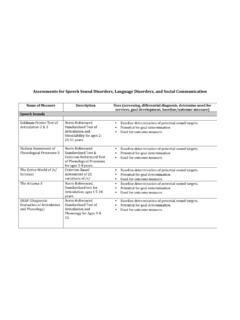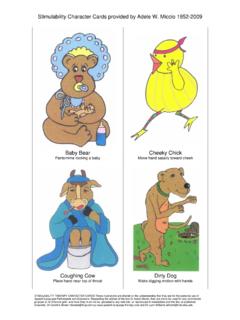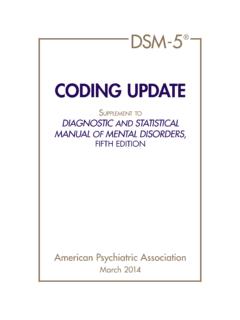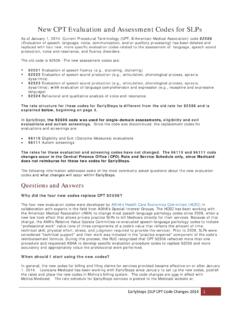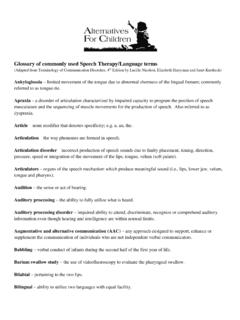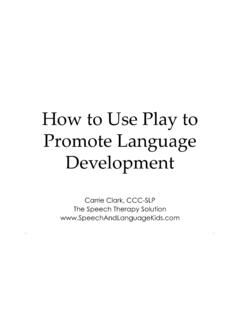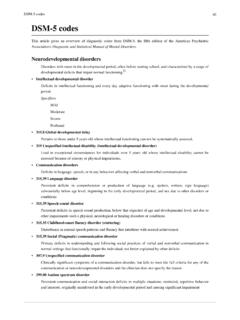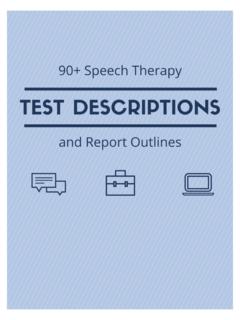Transcription of Language Development F 9 - SAGE Publications Inc
1 289 Language Development9289 Language DevelopmentFrom their very first cries, human beings communicate with the world around them. Infants communicate through sounds (crying and cooing) and through body lan-guage (pointing and other gestures). However, sometime between 8 and 18 months of age, a major developmental milestone occurs when infants begin to use words to speak. Words are symbolic representations; that is, when a child says table, we understand that the word represents the object. Language can be defined as a system of symbols that is used to communicate. Although Language is used to communicate with others, we may also talk to ourselves and use words in our thinking.
2 The words we use can inf luence the way we think about and understand our defining some basic aspects of Language that we use throughout the chapter, we describe some of the theories that are used to explain the amazing process by which we understand and produce Language . We then look at the brain s role in processing and pro-ducing Language . After a description of the stages of Language Development from a baby s first cries through the slang used by teenagers we look at the topic of bilingualism. We examine how learning to speak more than one Language affects a child s Language develop-ment and how our educational system is trying to accommodate the increasing number of bilingual children in the classroom.
3 Finally, we end the chapter with information about disorders that can interfere with children s Language of LanguageThere are four basic aspects of Language that have been studied: phonology, syn-tax, semantics, and pragmatics. Phonology is the study of the sounds of a Language . (To remember this term, think of the sounds that come from your telephone, or the word cacophony, meaning a lot of loud, annoying sounds.) Synta x is the grammar of a Language that is, how we put words in order and how we change words (for example, play becomes played when we talk about the past) so they make sense to our listeners. Semantics is the meanings of words. Pragmatics is how we use Language .
4 For example, you probably speak in different ways to your professor, to your friends, and certainly to a 2-year-old. In each case, you are using Language in a different way. When children develop the ability to communicate with Language , they are developing all four of these areas (Gleason, 2005). They must understand and form the sounds of the Language they are learning. They must learn what words mean and how to put them together so they make sense, and they must learn when and how to use Language to accommodate their listeners and to accomplish their goals. We consider all of these aspects as we describe Language basic units are central to the study of Language and its Development : morphemes and phonemes.
5 A morpheme is the smallest unit that has meaning in a Language . For example, the word cats has two morphemes: cat and s. Cat refers to the animal, and s means more than one. A phoneme is the smallest distinct sound in a particular Language . For 9 Language A system of symbols that is used to communicate with others or in our The study of the sounds of a The grammar of a The study of the meanings of The rules that guide how we use Language in social The smallest unit in a Language that has The smallest distinct sound in a particular III: Building Blocks of Development 290example, go has two phonemes: g and o, and check has three phonemes: ch, e, and ck (National Reading Panel, 2000a).
6 Different languages have types of phonemes that are distinct. For instance, in Japanese, the length of a vowel can indicate a different word. The word toko means bed, while toko with a long final o means travel (Sato, Sogabe, & Mazuka, 2010). In English, no matter how long we draw out the a in cat, it still means cat. Theories of Language DevelopmentThere are many different ideas about how children learn to talk and understand Language , and many controversies persist to this day. We are still learning about how this amazing process can occur so quickly in the first years of and Social Cognitive Learning TheoryIf you were to take a survey of people on the street and ask them how children learn Language , the chances are that many would answer by imitation.
7 Of course imitation must play an important role. After all, children learn the lan-guage that they hear, not some other Language . The idea that Language is learned through imitation is con-nected with Bandura s theory of social cognitive learning that we read about in Chapter 2. Imitation is the central learning principle of social cognitive learning theory. According to B. F. Skinner (1957/1991), Language is also shaped through oper-ant conditioning and the use of rein-forcement. When we respond to a baby s babbling with a smile or some vocalization of our own, babies babble even more. If we respond to a request for cookie with the desired cookie, it becomes more likely that the child will use that word again the next time she wants a cookie.
8 If we remem-ber that reinforcement is anything that makes a behavior continue, then it is clear that we reinforce the Development of a child s Language in many ways. Consistent with these ideas, research has shown that the more that mothers respond to their babies vocalizations, the sooner their babies develop Language (Tamis-LeMonda, Bornstein, & Baumwel l, 20 01).NativismIn contrast to the ideas proposed by operant conditioning and social cognitive theory, both of which focus on interactions in the environment, Noam Chomsky (1968) developed a theory that proposes that the human brain is innately wired to learn Language , a theory known as nativism.
9 He believes that children could not learn something as complex as human Language as quickly as they do unless there is already a grammatical structure for Language hardwired in their brains A mother-infant conversation. Social cognitive theory emphasizes the importance of social interaction for Language learning. As this mother talks to her infant, she models using Language to communicate, and the infant wants to imitate his mother to continue the fun. Nativism A theory of Language Development that hypothesizes that human brains are innately wired to learn Language and that hearing spoken Language triggers the activation of a universal 9: Language Development291before they ever hear human Language .
10 He calls this universal grammar. According to this theory, hearing spoken Language triggers the activation of this structure and does more than just promote imitation. Chomsky believes that the Language that we usually hear is not enough on its own to explain the construction of all of the rules of Language that children quickly instance, nativists such as Chomsky point to the evidence that children will say things they have never heard, such as The cats eated the mouses rather than The cats ate the mice. We hope that children have never heard adults say something like eated or mouses, and therefore they could not just be imitating Language they have heard.










